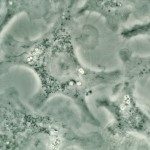Link to Pubmed [PMID] – 8732352
J. Med. Vet. Mycol. 1996 Mar-Apr;34(2):83-90
Peptidolytic activity was studied in the broken-cell extracts of 17 isolates of pathogenic fungi tested with phenylazobenzyloxycarbonyl-Pro-Leu-Gly-Pro-Arg (PZ-PLGPA) as a substrate. All the fungi studied except Candida spp., Cryptococcus neoformans and two actinomycetes hydrolyzed the substrate and therefore contained a so-called PZ-peptidase activity. Of all the positive strains, Trichophyton schoenleinii, a pathogenic fungus showed the highest activity and was therefore chosen as a source for PZ-peptidase purification. The four chromatographic steps, a ‘negative’ dye column, a ‘positive’ dye column, hydroxyapatite Ultrogel, and modified TSK (HW 55), gave a highly purified peptidase with a 12% overall yield. Inhibitor studies suggested that the 82 000 M(r) PZ-peptidase is a metalloproteinase. Moreover it cleaved native rat type I collagen. Partial peptide sequencing showed a strong sequence homology to regions of two metalloproteinases previously identified in the yeast Saccharomyces cerevisiae and in rat.
